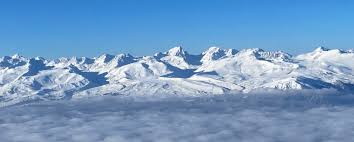Growing Pir Panjal ranges contributed to Kashmir’s present-day Mediterranean weather: Study

Srinagar, July 22 — Kashmir’s distinctive climate, often described as Mediterranean due to its dry summers and wet winters, has puzzled climatologists and geographers for decades. Now, a recent scientific study has shed new light on the geological forces behind this unique weather pattern, revealing that the growth of the Pir Panjal mountain range played a decisive role in shaping Kashmir’s present-day climate.
The research, conducted by a team of geoclimatologists and published in the journal Climate Dynamics, combines fossil evidence with climate modeling to explain how millions of years of tectonic activity led to the region’s characteristic seasonal rainfall and temperature variations. This discovery not only deepens our understanding of Kashmir’s environment but also helps explain its unique biodiversity and agricultural productivity.
The Mystery of Kashmir’s Mediterranean Weather
Kashmir lies nestled in the western Himalayas, a region typically influenced by the South Asian monsoon. Most parts of northern India experience heavy rainfall during summer monsoon months, but Kashmir’s climate is strikingly different. It receives most of its precipitation during winter, brought by western disturbances — moisture-laden weather systems originating from the Mediterranean and Central Asia.
This unusual rainfall distribution leads to dry, warm summers and cold, wet winters, a pattern resembling Mediterranean climates found thousands of kilometers away in parts of southern Europe, California, and coastal Chile.
For years, scientists debated why Kashmir diverged so significantly from surrounding areas that have a monsoon-dominated climate. The new study provides a convincing answer: the uplift of the Pir Panjal ranges acted as a natural barrier, altering wind and precipitation patterns.
The Geological Role of the Pir Panjal Range
The Pir Panjal mountain range forms the southwestern segment of the Lesser Himalayas and stretches across parts of Jammu and Kashmir and Himachal Pradesh. Its formation is closely linked to the collision between the Indian and Eurasian tectonic plates, which began approximately 50 million years ago and continues today.
Dr. Rakesh M. Singh, lead author and geoclimatologist at the National Institute of Earth Sciences, explains: “As the Pir Panjal ranges grew taller over millions of years, they started to obstruct the monsoon winds moving from the Bay of Bengal and Arabian Sea. This resulted in a marked reduction of summer rainfall in the Kashmir Valley.”
At the same time, the mountains allowed the western disturbances, which arrive from the Mediterranean and Central Asia, to continue bringing precipitation during winter months. This combination effectively rewired Kashmir’s climate system, giving rise to the Mediterranean-like pattern.
Evidence from Ancient Sediments and Vegetation
To unravel this climatic puzzle, the researchers analyzed sediment cores extracted from ancient lake beds in the Kashmir Valley. These cores contain layers of fossil pollen, plant remains, and mineral deposits that serve as natural archives of past climate conditions.
“We observed a clear transition in pollen assemblages,” says Dr. Singh. “Around the time the Pir Panjal uplift accelerated, there was a marked shift from tropical and subtropical plant species toward temperate and alpine vegetation. This indicates cooler and drier summers, consistent with Mediterranean climates.”
The team complemented these findings with sophisticated climate simulations, which modeled atmospheric flow patterns with and without the Pir Panjal barrier. The results confirmed that the presence of the mountain range significantly diminished summer monsoon penetration into the valley, while preserving winter moisture from western disturbances.
Implications for Biodiversity and Agriculture
Kashmir’s Mediterranean climate has contributed to the region’s rich biodiversity, which differs from that found in the surrounding subcontinent. The dry summers and snowy winters create conditions favorable to many endemic species of plants and animals.
The climate also supports the valley’s renowned horticulture industry. Fruits such as apples, walnuts, cherries, almonds, and saffron flourish here, benefiting from the distinct seasonality of temperature and rainfall. “This climatic uniqueness is a key factor in Kashmir’s agricultural identity,” notes Dr. Singh.
Understanding how the Pir Panjal uplift influenced climate helps explain why the valley became a hotspot for both natural diversity and human settlement focused on farming and horticulture.
A Broader Perspective on Climate Evolution
This study not only uncovers the origins of Kashmir’s climate but also offers insights into how tectonics and topography can shape regional weather patterns over geological time. Mountain ranges worldwide influence rainfall and temperature by redirecting winds and moisture — but Kashmir presents a particularly clear example of this process.
Professor Ayesha Hamid, an independent environmental scientist, comments, “The research elegantly links deep-time geological processes to current climate regimes. It reminds us that Earth’s climate system is highly dynamic and sensitive to shifts in the planet’s physical geography.”
With ongoing climate change threatening to alter precipitation patterns and snow cover in the Himalayas, understanding the natural history of Kashmir’s weather could prove vital for managing water resources, agriculture, and ecosystems in the future.
What Lies Ahead: Climate Change and Regional Resilience
Kashmir has already experienced noticeable changes in climate trends — including shifts in snowfall timing, retreating glaciers, and varying rainfall patterns. These changes impact agriculture, water availability, and the livelihoods of millions in the region.
By illuminating the deep geological roots of Kashmir’s Mediterranean climate, the study provides a baseline for understanding how resilient the region’s climate system might be in the face of rapid environmental changes. It also highlights the importance of preserving the Pir Panjal ranges, not just for their natural beauty, but for their role in sustaining the valley’s unique climate and ecology.
Conclusion
The study on the growing Pir Panjal ranges has opened a window into the ancient past, revealing how mountain formation has shaped one of South Asia’s most distinctive climates. From the geological uplift millions of years ago to the present-day weather patterns that influence biodiversity and agriculture, Kashmir’s Mediterranean climate is a product of intricate Earth systems working together.
As researchers continue to study the complex interplay of geology, climate, and ecology in the Himalayas, these insights may prove crucial in safeguarding Kashmir’s environment and supporting sustainable development in this beautiful and unique region.






